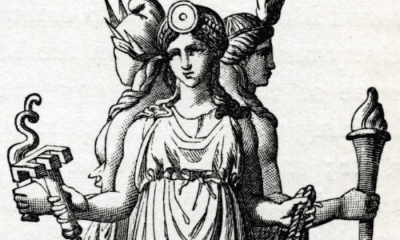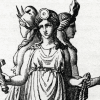Greek
What Does Cerberus Represent?
Cerberus, the multi-headed dog of the Underworld, may have all the markers of a monster but the myths show him as a terrifying ideal of a good dog.
Cerberus, the hound of Hades, has many of the characteristics of a vicious monster in Greek mythology. Attributes like a snake’s tail and multiple heads put him in the family of some of the worst beasts of legend.
While there are many descriptions of the hell-hound’s terrifying appearance, however, there are few stories in which he actually acts as ferociously as he looks. Instead, the guard god of the Underworld is shown as diligent, watchful, and dutiful.
Cerberus was said to attack if one of the souls he watched over attempted to escape, but for mortals entering the land of the dead he was relatively easy to bypass. On the one occasion that he was forced to leave his post, he immediately returned as soon as he was able.
Cerberus represented many aspects of death, danger, and the Underworld but more than anything he could simply represent the ideal guard dog.
Cerberus the Hell-Hound
Cerberus was a monstrous god who guarded the gates of the Underworld. He stood watch at the River Acheron, one of the main entryways to the realm of Hades.
When a soul was ferried across the river by Charon, Cerberus watched as they made their way to be judged by the mortal kings who oversaw the division of souls. More importantly, the only way the souls of the dead could get out of their realm was to go past the dreadful dog.
In the Greek view of the afterlife, keeping the souls of the dead in the Underworld was far more important than keeping the living away. While few dared to go to the realm of Hades of their own accord, the dead were eager to escape and cause trouble on earth.
As the guardian of one of the Underworld’s most important entrances, Cerberus was eternally watchful.
While he is usually depicted with three heads, some writers gave him as many as fifty. So many eyes meant that he could stay on watch at all times.
A giant animal, he towered above the gates he watched. Some accounts also said he had a snake in place of a tail, and several more serpents protruding from his back, neck and joints.
Later images gave the dog qualities of a lion as well. He had great claws, a shaggy mane, or a more lion-like face in later Greek and Roman images.
Such a depiction was meant to do more than frighten. It also displayed the hell-hound’s function and power.
Snakes, like dogs, were animals often associated with the Underworld and death. Many monsters had serpentine qualities to emphasize their deadliness and connection to the land of the dead.
Despite his monstrous appearance and frightening duty, Cerberus was not described as an inherently evil or violent creature. Some writers went so far as to say that he was friendly toward the souls of the dead under his charge, provided that none try to escape the Underworld.
The only time Cerberus ever left his post was when Hades reluctantly allowed Hercules to overcome the beast and take him to the surface to complete the last of his twelve labors. According to most accounts, the dog was so devoted to his duty that he immediately ran back to the River Acheron the moment he was released.
My Modern Interpretation
The characterization of Cerberus is not that of a vicious monster, but of a loyal guard dog.
Dogs in the ancient world were more than just pets. They were working animals who were bred and trained to assist their human owners.
The most common duty of a dog was to be a guardian. Whether in the home or among the flocks and herds of the farm, it was a dog’s job to be watchful.
Although Cerberus appeared terrifying, he was in many ways an exaggerated version of the characteristics necessary for a good guard dog.
Having many heads or eyes was a common trait for supernatural guardians in Greek mythology. Whether watching over the Underworld, like Cerberus, or a hostage, like Argus, many eyes were thought to ensure that one could always be on the lookout for potential trouble.
This made Cerberus monstrous, but not necessarily evil. Like many other guardians, he could be brutal in the execution of his duty but was otherwise non-threatening.
In fact, unrestrained ferocity would be a negative attribute for a guard dog. A shepherd’s dog, for example, who was overly violent would be just as likely to attack the sheep it watched over as it would a wolf who tried to steal them.
Like a good dog, therefore, Cerberus was not threatening to the souls of the dead. Only if they tried to escape would he lash out at them, like a herding dog ensuring that none of the flock stray too far away.
While a living dog might nudge a straying sheep or nip at its legs, however, Cerberus would pounce on escaping souls and devour them. Crossing Cerberus meant an end to even the foggy and dreary afterlife promised by traditional Greek belief.
Like the most devoted dogs, Cerberus was also dedicated to his duty. He was described as standing eternally over the River Acheron, never allowing himself to be distracted or wander away.
In later myths, Cerberus could be bypassed in much the same way as a living guard dog could be a would-be thief. More than one Hellenistic and Roman myth claimed that Cerberus was fond of honey cakes, and could be induced to eat a sedative if given his favorite treat.
There is even some indication of Cerberus being seen as a beloved pet. The most common story, for example, says that Hades allows Cerberus to be taken by Hercules only if the hero can promise that no harm will come to the dog.
In one telling of the story of the twelfth labor of Hercules, Hades is so enraged by the demand to steal his dog that, while he allows Hercules to take the hound to the surface, he seeks revenge on the king who ordered it done.
When Hades appears before King Eurystheus, the terrified man admits that he sent Hercules to the Underworld but says that he did so on the command of Hera. Hades is so protective of his dog that he threatens war against his sister if she ever commits such a treacherous act again.
Cerberus has the physical characteristics of a vicious monster in Greek mythology. While writers often described him as terrifying and ferocious, however, the myths involving the hound of Hades paint a picture much more reminiscent of a faithful and dutiful guard dog than a man-eating beast.
A great guard dog, like Cerberus, often looks terrifying enough to frighten away would-be thieves before they act so that it rarely has to attack at all.
In Summary
Cerberus was the multi-headed guard dog of the Underworld. He was usually shown as monstrously-sized and often with features of snakes and lions.
His appearance was certainly terrifying, and writers described at length his ferocity and the danger he posed. In his actual actions, however, the hound of Hades appeared much less threatening.
The primary duty of Cerberus was not to watch against intruders, but to make sure that none of the souls of the dead escaped into the land of the living. He was described as exceptionally diligent in this task.
His many heads gave him several sets of eyes to keep watch over his charges. Most of those said to have entered the Underworld, however, had little trouble getting past the dog. He could even be bribed with his favorite treats.
His watchfulness and devotion were what could be expected of a good guard dog. While he was monstrous, as was fitting for an Underworld guardian, Cerberus is shown as mindful rather than indiscriminately violent.
He is even occasionally shown as a beloved pet to his chthonic master.
Cerberus was no doubt a monster, but unlike many of his kin he represented a value as well as a danger. While a good guard dog could be ferocious and intimidating, it was also obedient and unwavering in its duties.



